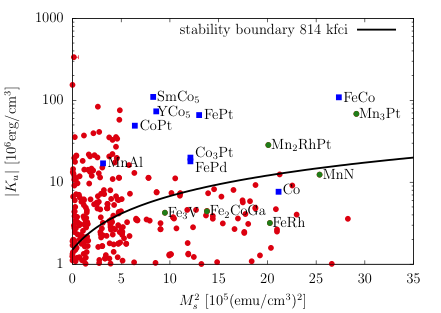Permanent magnets due to spontaneous tetragonalization by interstitials

Structural distortions imposed on cubic ferromagnets can induce significant perpendicular magnetic anisotropy (PMA) by reducing the crystalline symmetry, and hence enhance magnetic coercivity which is crucial for permanent magnets. Nevertheless, it is a difficult task to maintain large enough homogeneous epitaxial strain in metallic bulk systems. In this work, by investigating the origin of PMA in Fe8Nx, we identify a novel route to engineer PMA by nitrogenation, which leads to distortions of both crystallographic and electronic structures.
Combining experimental characterization and first principles calculations, the role of induced tetragonal distortions due to interstitial N atoms in epitaxial α′-Fe8Nx films is found to be responsible for enhanced magnetization, while the occurrence of PMA is attributed to specific Fe atoms with significant displacements caused by N atoms.
Based on our DFT calculations, it is observed that the perpendicular magnetic anisotropy observed in α′-Fe8Nx cannot be explained solely by the tetragonal distortions. For instance, our DFT calculations using the experimental lattice parameters indicate that there is a spin reorientation transition for Fe with enhanced tetragonal unit cell (cf. Figure). That is, for Fe with lattice constants of α′-Fe8N with c/a ~ 1.1, the spontaneous magnetization is in-plane, in contrast to the perpendicular magnetization.
The scenario can also be applied to other materials and thus is promising for further high-throughput investigations. To get some clue about the sensitivity of magnetic anisotropy versus the tetragonal distortions, we performed massive DFT calculations on cubic magnetic materials with 1% epitaxial strain imposed. It is observed that epitaxial strain in thin films can lead to a strong enhancement of the magnetic anisotropy, resulting in magnetic properties comparable to the best-known hard magnets.
Based on the high throughput calculations, we identified three classes of cubic materials to try out with various interstitials (H, B, C, and N). For compounds with Cu3Au structure, it is observed that in MnNi3 and FeNi3 interstitial N induces a tetragonal distortion with moderate uniaxial MAE for realistic N concentrations. Mn3X (X = Rh, Ir, Pt and Sb) with interstitial N are identified as alloys with strong magneto-crystalline anisotropy. For Mn3Ir we find a strong enhancement of the MAE in the most stable collinear ferrimagnetic state as well as in the non-collinear magnetic ground state. Based on these results we expect that interstitial N has also a strong impact on amorphous Mn3Ir, which is an important exchange bias material.
The same idea has been applied to the cubic Heusler compounds, whose crystal structure is essentially the same as bcc. Based on high-throughput density functional theory calculations, we investigated the effects oflight interstitial H, B, C, and N atoms on the magnetic properties of cubic Heusler alloys, focusingon designing rare-earth free permanent magnets. It is observed that the interstitial atomsinduce significant tetragonal distortions, leading to 32 candidates with large (> 0.4 MJ/m3) uniaxialmagneto-crystalline anisotropy energies (MAEs) and 10 cases with large in-plane MAEs.Detailed analysis following the the perturbation theory and chemical bonding reveals the strongMAE originates from the local crystalline distortions and thus the changes of the chemical bondingaround the interstitials. This provides a valuableway to tailor the MAEs to obtain competitivepermanent magnets, filling the gap between high performance Sm-Co/Nd-Fe-B and widely usedferrite/AlNiCo materials.






